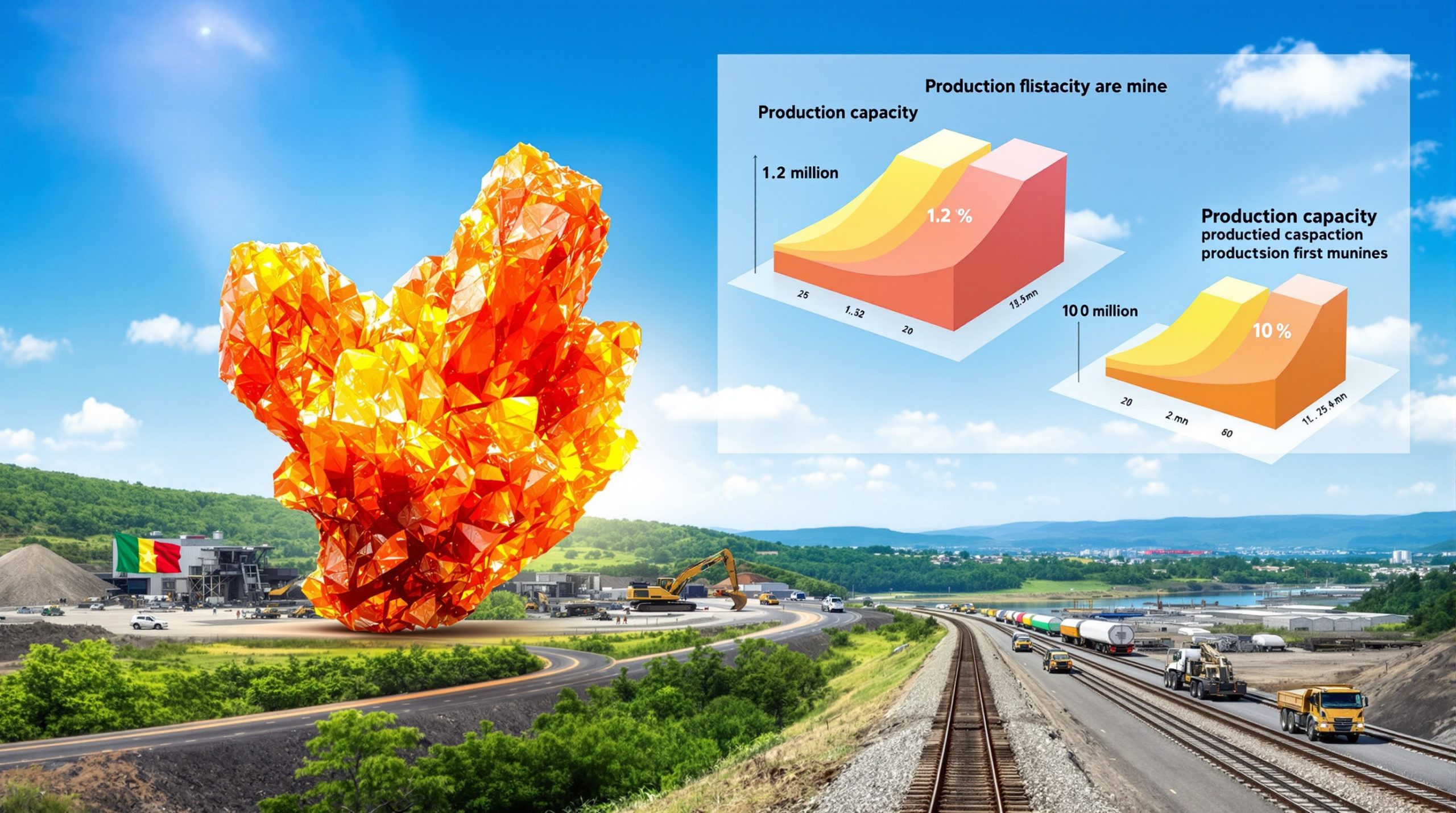What Are Rare Earth Elements and Why Are They Important?
Rare earth elements (REEs) represent a group of 17 metallic elements crucial to modern technology and industrial applications. Despite their name, most REEs are relatively abundant in the Earth's crust, but they rarely occur in concentrated, economically viable deposits. The seven elements recently restricted by China—including yttrium, dysprosium, and terbium—have become the focal point of global rare earth supply chain concerns due to their irreplaceable properties in critical applications.
REEs possess unique atomic structures that enable exceptional magnetic, luminescent, and electrochemical properties. These characteristics make them indispensable in manufacturing high-performance magnets, batteries, catalysts, and various electronic components. According to industry data, China currently accounts for approximately 90% of global rare earth production, creating a precarious dependency for technology manufacturers worldwide.
Critical Components for Modern Technology
The strategic importance of REEs extends across multiple industries. In the defense sector, elements like dysprosium are vital components in guided missile systems, radar equipment, and communication technologies. One industry analyst noted, "China's control over REEs provides significant leverage in global tech and defense markets," highlighting the national security implications of restricted access.
In the energy sector, REEs play a foundational role in the clean energy transition. Wind turbines require approximately 600 kg of rare earth elements per megawatt of generating capacity, while electric vehicle motors depend on neodymium-iron-boron magnets containing dysprosium and terbium. These specialized materials enable the high-temperature performance and magnetic strength necessary for efficient operation.
The automotive industry's shift toward electrification has dramatically increased demand for REEs, with global consumption estimated at 140,000 metric tons annually. This demand continues to grow as manufacturers expand their electric vehicle offerings and renewable energy installations increase worldwide.
Strategic Importance in Global Supply Chains
Beyond their technical applications, REEs represent a strategic resource in global geopolitics. Their concentration in Chinese supply chains creates vulnerabilities for numerous industries and national economies. The unique atomic properties of REEs—which enable high magnetic strength and thermal resistance—cannot be replicated by substitute materials without significant performance compromises.
The manufacturing of specialty glass, phosphors used in displays, and polishing compounds all depend on specific rare earth elements. Healthcare technologies, including MRI machines and certain cancer treatments, also utilize REEs for their unique properties. This diversified application landscape amplifies the impact of supply disruptions across multiple sectors simultaneously.
As one trade analyst observed, "The market has underestimated how quickly REE stockpiles can deplete in the absence of consistent Chinese exports." This vulnerability highlights the complex interdependencies in global supply chains and the strategic foresight required to mitigate risks in critical mineral shortages access.
How Did China Establish Dominance in the Rare Earth Market?
China's current dominance in the global rare earth market represents the culmination of decades of strategic planning, significant investment, and coordinated policy implementation. The country's approach to rare earth development demonstrates an exceptional long-term vision that has positioned China as the controlling force in this critical resource sector.
China's Market Share and Production Capacity
China's 90% market share in global rare earth production didn't happen by accident. Through approximately 30 years of sustained strategic investment, China has built an unparalleled mining infrastructure spanning multiple provinces. The Bayan Obo mine in Inner Mongolia alone accounts for approximately 45% of global rare earth production, representing the single largest concentration of rare earth mining capacity worldwide.
Beyond raw material extraction, China controls approximately 85% of global rare earth refining capacity. This vertical integration—from mining to processing to manufacturing—creates a comprehensive ecosystem that other countries struggle to match. The development of solvent extraction processes in the 1980s enabled Chinese facilities to reduce processing costs by approximately 40%, creating significant competitive advantages over international competitors.
Chinese dominance extends beyond production volume to include technical expertise, research capabilities, and the development of downstream applications. As one industry report indicated, "China's rare earth strategy encompasses the entire value chain, from exploration to end-use manufacturing, creating interdependencies that are challenging for competitors to overcome."
Historical Development of China's Rare Earth Industry
China's rare earth industry evolved through carefully orchestrated policy shifts that prioritized these elements as "strategic resources" beginning in the 1990s. Under state direction, Chinese enterprises systematically acquired foreign processing technology, developed indigenous expertise, and expanded production capacity while many Western nations divested from rare earth processing due to environmental concerns and cost pressures.
The country's rare earth policies included export quotas implemented in 2006, production consolidation under state-owned enterprises, and environmental regulations that eliminated smaller, non-compliant producers. These coordinated policies concentrated control while simultaneously addressing legitimate environmental concerns associated with rare earth processing.
Chinese investment in rare earth technologies extends to patent acquisition and research development. Chinese entities have systematically acquired intellectual property related to rare earth applications, processing techniques, and substitution technologies. This comprehensive approach demonstrates a sophisticated understanding of the strategic value of controlling both physical resources and associated intellectual property.
As one mining industry expert observed, "China recognized the strategic importance of rare earths decades before Western nations, allowing them to establish dominance while others focused on short-term economic considerations." This historical advantage has proven difficult for competing nations to overcome despite increasing awareness of supply chain vulnerabilities.
What Triggered China's Recent Export Restrictions?
China's implementation of export controls on seven critical rare earth elements represents a calculated response to broader geopolitical tensions and trade disputes. These restrictions demonstrate China's willingness to leverage its resource dominance as a strategic tool in international relations.
Escalating Trade Tensions with the United States
The export restrictions serve as a direct response to U.S. tariff increases on approximately $50 billion worth of Chinese goods. As trade relations deteriorated, China identified America's dependency on rare earth elements as a potential pressure point in ongoing negotiations. One trade analyst noted, "This specifically targets U.S. reliance on Chinese rare earths for critical defense applications, including F-35 fighter jets and other advanced weapons systems."
China's approach represents a sophisticated understanding of supply chain vulnerabilities. By restricting elements critical to high-technology applications rather than imposing broad trade barriers, China can calibrate economic pressure while minimizing self-harm. This targeted strategy affects approximately 60% of U.S. defense systems that rely on Chinese rare earth elements.
The timing of these restrictions coincides with the U.S. Defense Logistics Agency's efforts to stockpile strategic materials, including approximately 10 tons of terbium acquired in 2024. However, these stockpiles may prove insufficient if China's export restrictions persist, creating potential vulnerabilities in defense manufacturing capabilities.
New Export Control Measures
China's Ministry of Commerce has implemented comprehensive licensing requirements through its electronic control system, adding bureaucratic complexity and uncertainty to the export process. These measures specifically target yttrium, dysprosium, terbium, and four other strategic elements critical for high-performance magnets and specialized electronics.
The licensing framework requires extensive documentation, including end-user certificates, environmental compliance reports, and detailed information about technical applications. As one customs broker explained, "There's no clarity on prioritization criteria—it's essentially a black box with unpredictable outcomes." This uncertainty amplifies the market disruption beyond the direct supply impact.
The export control system lacks transparency regarding processing timelines, approval criteria, or appeal mechanisms. Industry sources report minimum 60-day backlogs for license approvals, with actual wait times potentially extending much longer. This administrative uncertainty compounds the market's ability to plan for and adapt to changing supply conditions.
China maintains that these controls represent legitimate national security measures rather than trade retaliation. However, the targeted nature of the restrictions—focused on materials with critical applications in defense and high-technology sectors—suggests a strategic calculation regarding economic leverage and negotiating positions in broader trade disputes.
How Are Global Supply Chains Being Affected?
The implementation of China's export restrictions has triggered immediate and cascading effects throughout global supply chains. The abrupt nature of these controls has left manufacturers, traders, and end-users scrambling to adapt to the new reality of constrained supply for critical materials.
Immediate Impact on Shipments and Deliveries
Industry reports indicate a 100% halt in yttrium shipments since April 2025, with similar disruptions affecting other controlled elements. One supplier stated, "Cargoes are stranded at Shanghai ports without customs clearance, creating significant uncertainty for buyers who had contracted these materials months in advance." This logistical paralysis affects both existing orders and future procurement planning.
The licensing requirements have created a complex documentation burden that many exporters struggle to navigate. Force majeure clauses have been invoked in approximately 12 international contracts, delaying an estimated $200 million in orders across multiple industries. These legal maneuvers reflect the severity of supply disruptions and their contractual implications.
Manufacturing operations have experienced direct impacts from these disruptions. Tesla reportedly reduced Q2 2025 electric vehicle production by approximately 15% due to magnet shortages, while other manufacturers face similar constraints. As one trader observed, "When clients ask when their cargoes will leave China, we estimate 60 days minimum, but it realistically may take significantly longer given the current approval backlog."
Stockpile Depletion Concerns
Industry experts warn that existing stockpiles of critical rare earth elements may deplete within 8-10 weeks for many U.S. manufacturers if the current situation persists. This timeline creates urgent pressure for supply chain managers to identify alternative sources or implement production adjustments to conserve materials.
The stockpile situation varies significantly across different industries and elements. Manufacturers with established inventory management practices may withstand longer disruptions, while just-in-time production systems face more immediate challenges. Sectors with high-volume consumption, including automotive manufacturing and consumer electronics, face particularly acute pressures as their material requirements cannot easily be reduced.
Supply chain disruptions extend beyond direct consumers of rare earth materials to impact component manufacturers, system integrators, and end-product assemblers. This ripple effect magnifies the economic impact across multiple industrial sectors. As one market analyst noted, "The interconnected nature of modern manufacturing means that shortages in specialized materials can paralyze production across entire industries."
Businesses have implemented emergency procurement strategies, including spot market purchases at premium prices. Reports indicate that some manufacturers, including Toyota, have paid up to 250% premiums for terbium in spot markets to maintain production schedules. These price premiums reflect both actual scarcity and market speculation regarding future availability.
What Are the Geopolitical Implications of China's Rare Earth Strategy?
China's rare earth export restrictions represent more than just commercial policy—they demonstrate the strategic leverage that resource dominance can provide in international relations. The calculated deployment of these controls offers insights into evolving geopolitical dynamics and economic statecraft.
Rare Earths as a Geopolitical Tool
China's willingness to leverage rare earth supply as a counter-measure in trade disputes signals a sophisticated understanding of critical resource dependencies. By targeting materials essential for advanced technology and defense applications, China can exert pressure on specific sectors while maintaining plausible deniability regarding broader trade retaliation.
One geopolitical strategist observed, "This accelerates NATO's push for mineral alliances and resource security initiatives," highlighting how China's actions catalyze counter-strategies among affected nations. The European Union's 2024 Critical Raw Materials Act, which allocates approximately €3 billion for mining diversification, represents one such response to perceived supply vulnerabilities.
The strategic significance of rare earth elements in military applications amplifies their geopolitical importance. Rare earths play crucial roles in hypersonic missile guidance systems, night vision technology, and communications equipment. These defense applications create national security implications that transcend commercial considerations, elevating supply security to a matter of strategic importance.
China's approach represents a calculated risk regarding its long-term market position. While current restrictions leverage existing dependencies, they simultaneously accelerate diversification efforts that may ultimately erode China's market dominance. This tension between short-term leverage and long-term position illustrates the complex calculations involved in the critical minerals race.
Potential Impact on US-China Relations
The rare earth restrictions represent another escalation in the complex economic relationship between the United States and China. By targeting materials critical to high-technology manufacturing and defense applications, China signals its willingness to use economic interdependencies as strategic leverage.
This development may accelerate broader economic decoupling efforts, particularly in technology sectors. As one policy analyst noted, "Critical resource dependencies create vulnerabilities that strategic competitors will eventually exploit—prompting defensive diversification strategies that reshape global supply chains." This assessment suggests that rare earth restrictions may contribute to more fundamental changes in U.S.-China economic relations.
The situation highlights the tension between economic interdependence and strategic competition. While deeply integrated supply chains create mutual benefits in stable times, they also create potential vulnerabilities during periods of geopolitical tension. This dynamic prompts reassessment of supply chain security, particularly for materials with strategic applications.
International responses to China's rare earth strategy will likely include expanded cooperation among affected nations. Japan, the European Union, and the United States have already initiated discussions regarding coordinated approaches to rare earth security, including joint research initiatives, stockpiling coordination, and investment in alternative sources.
How Are International Buyers Responding to the Crisis?
Faced with unprecedented supply uncertainty, international buyers of rare earth elements are implementing multifaceted strategies to manage immediate shortages while developing longer-term solutions to reduce vulnerability to future disruptions.
Diversification Strategies
Major rare earth consumers are accelerating investments in alternative production sources outside China. Australia's Lynas Corporation, the largest non-Chinese producer, has announced plans to double production of neodymium-praseodymium (NdPr) by 2026. According to their CEO, "We're investing $500 million in Malaysian processing plants to meet growing demand from customers seeking supply chain diversification."
Companies are also intensifying efforts to develop rare earth recycling capabilities. Bioleaching techniques can now recover approximately 95% of rare earth elements from electronic waste, offering a potentially significant supplementary source. Apple has committed to using 30% recycled rare earth elements in iPhones by 2025, demonstrating the commercial viability of circular supply approaches.
Material substitution research has accelerated as manufacturers seek to reduce dependence on volatile supplies. While finding perfect substitutes remains challenging, partial substitution can reduce overall consumption. Companies like Niron Magnetics are developing iron-nitride magnets that could replace certain rare earth applications, although performance specifications remain below traditional rare earth magnets for high-temperature applications.
Stockpiling has emerged as an immediate response strategy, with manufacturers increasing inventory levels despite higher carrying costs. This defensive approach provides operational buffer against supply disruptions but creates additional demand pressure in already constrained markets.
Long-Term Market Restructuring
China's export restrictions have catalyzed fundamental reassessment of rare earth supply chains, potentially reshaping market structures over the longer term. Industry sources predict accelerated investment in processing capabilities outside China, with projects in Vietnam, Malaysia, and Estonia receiving particular attention due to their existing technical expertise.
Vertical integration strategies have gained momentum as manufacturers seek control over their supply chains. Several automotive manufacturers have formed joint ventures with mining companies to secure priority access to materials. These arrangements represent a structural shift away from market-based procurement toward strategic supply partnerships with long-term commitments.
Policy support for supply diversification has expanded globally. The United States implemented the Inflation Reduction Act with specific provisions supporting domestic rare earth production, while the European Union's Critical Raw Materials Act provides financial incentives and regulatory support for European production and processing capabilities.
As one mining sector analyst observed, "China's actions may ultimately cost them market share as buyers who might have accepted the status quo are now committed to finding alternatives." This assessment suggests that short-term supply leverage may accelerate long-term market restructuring in ways that ultimately reduce China's dominant position in the emerging commodity super cycle.
What Is the Timeline for Export License Processing?
The implementation of China's export licensing system has created significant uncertainty regarding processing timelines, approval criteria, and operational procedures. This administrative opacity compounds the market disruption beyond the direct supply impact.
Current Processing Delays
Industry sources estimate a minimum 60-day waiting period for export license applications, with actual timelines potentially extending significantly longer. This creates operational challenges for both Chinese exporters and international buyers attempting to plan production schedules and inventory management.
License applications for shipments of 20 tons of dysprosium destined for General Electric remain unprocessed after several weeks, exemplifying the broader delays affecting the industry. As one customs broker explained, "There's no clarity on prioritization—it's essentially a black box with unpredictable outcomes." This uncertainty magnifies the disruption as companies cannot reliably plan for resumption of normal supply.
The processing delays affect not only new export applications but also shipments already at ports awaiting customs clearance. According to Reuters reporting, numerous cargoes are stranded at Shanghai and other ports, creating additional logistics costs and contractual complications for buyers and sellers alike.
Chinese authorities have provided limited guidance regarding expected processing timelines, creating ambiguity that amplifies market uncertainty. This administrative opacity appears deliberate, potentially serving as a form of strategic ambiguity that maximizes the disruptive impact while maintaining regulatory flexibility.
Navigating the New Licensing Requirements
The licensing process requires extensive documentation, including end-user certificates, environmental compliance reports, and detailed information about technical applications. Exporters report
Want to Invest in the Next Major Mineral Discovery?
Discovery Alert instantly notifies investors of significant ASX mineral discoveries using its proprietary Discovery IQ model, transforming complex data into actionable insights. Explore why historic discoveries can generate substantial returns by visiting Discovery Alert's dedicated discoveries page and start your 30-day free trial to position yourself ahead of the market.




